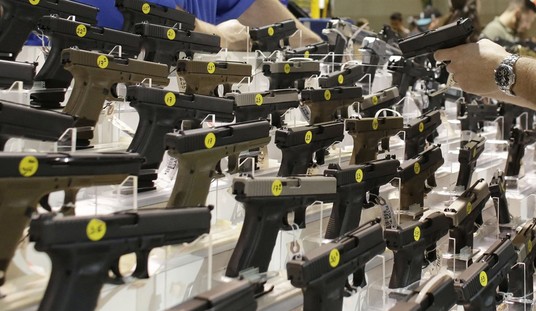We’ve found two interesting news items relating to federal court cases this morning, particularly regarding cases of not just keeping arms, but bearing them in public.
First, a pair of cases from Texas and Louisiana:
The U.S. Supreme Court is expected to decide this month whether to hear two cases seeking clarification on what the Constitution’s framers intended in granting citizens the right to not only own but also “bear” arms.
…
In one case, rooted in Texas, the NRA is reportedly challenging a state law permitting minors to own guns, but stipulating all the same that they are, in fact, too young to apply for — and thus possess — the license necessary to carry them in public.
“The explicit guarantee of the right to ‘bear’ arms would mean nothing,” the NRA’s filing in the Texas matter reportedly argues, “if it did not protect the right to ‘bear’ arms outside of the home, where the Amendment already guarantees that they may be ‘kept.’
“The most fundamental canons of construction forbid any interpretation that would discard this language as meaningless surplus.”
In the other case, the NRA is reportedly challenging a decision rendered earlier by the 5th U.S. Circuit Court of Appeals in New Orleans that upheld federal and state laws governing minors’ access to guns.
While the Supreme Court affirmed the right to “keep” a firearm six years ago, it has reportedly refused in the ensuing epoch to take up the question of what exactly it means to “bear” arms and where one can carry them.
A third possible “bearing” case comes to us from Ohio, where two of three judges in an Ohio Court of Appeals case have ruled that “bearing” extends to a person’s vehicle, and not just their homes as collectivists continue to argue (link goes to Volokh on the Washington Post; direct link to the court’s server seems to be overwhelmed).
Though Heller and McDonald say that “‘the need for defense of self, family, and property is most acute’ in the home,” that language does not mean that the need for defense of self, family and property never arises out of the home. Moore, 702 F.3d at 935. In fact, by using the modifier “most” in front of “acute,” the court acknowledged the need for self-defense in places other than the home. As the Second Amendment primarily ensures the right of an individual to bear arms “in case of confrontation,” surely the contours of that right would extend to situations where an individual would need to act in self-defense outside the individual’s home. Heller, 554 U.S. at 592.
Moreover, because the court identified reasonable restrictions such as “carrying [] firearms in sensitive places such as schools and government buildings,” the court clearly acknowledged that the scope of the Second Amendment reaches beyond the home. Heller, 554 U.S. at 626–627. Otherwise, such “restrictions” need not be identified or examined….
Furthermore, it is significant that the language of the Second Amendment protects the right of the people to both “keep and bear Arms.” (emphasis added). I agree with the Seventh Circuit’s observation that “The right to ‘bear’ as distinct from the right to ‘keep’ arms is unlikely to refer to the home. To speak of ‘bearing’ arms within one’s home would at all times have been an awkward usage. A right to bear arms thus implies a right to carry a loaded gun outside the home.” Moore, 702 F.3d at 936.
In the instant case, I would hold that the right to bear arms ensured by the Second Amendment does, in fact, extend to motor vehicles. I would further conclude that R.C. 2923.16(B) is narrowly tailored to serve a significant government interest, and that it adequately leaves open alternative means for an individual to assert his or her Second Amendment right to bear arms.
While Heller was in general a decent SCOTUS decision, it left far more questions than answers about where the court stands on 2nd Amendment issues, which allows (to this day) lower court decisions and laws that seem to fly in the face of the Founder’s desires regarding our Second Amendment rights.
The more I read and educate myself on the context in which the Second Amendment was written, the more certain I feel that the Founders were acutely aware of rapid evolution in firearms technology that happened during the war.
Smooth-bore, muzzle-loading muskets that formed the bulk of the might for most infantrymen of the age, but the time period also saw development of breach-loading rifles like the Ferguson and Girandoni, which doubled both the range and the rate of fire of the muskets. The Founders knew that firearms technology would continue to develop ever-faster-firing, much-longer-ranged firearms. While there isn’t anything I’ve found that suggests they would have been able to imagine nuclear weapons, we aren’t talking about deploying nuclear weapons in civilian hands, are we? The Founders clearly understood (and in many cases, used or directly observed) hand grenades, rockets, mortars, cannon, howitzer, muskets, the evolution of fast-firing rifles and multi-shot pistols of various designs.
I firmly believe that while the Founders could not know which specific direction small arms development might take, they were very much aware that faster-firing, longer-ranged and more accurate weapons were constantly under development, and they clearly meant for the citizenry of every future age to be armed with arms of contemporary military utility to defend the nation not just from foreign invaders, but domestic enemies, specifically including our own government.
Only time will tell, but it may very well be that these cases rising through the court system will once again dash the fever-dreams of gun control cultists, and pave the way for the dismantling of blatantly unconstitutional guns laws.
Update: Tennessean Leonard Embody writes Bearing Arms to remind us that Embody v Cooper was placed on the U.S. Supreme Court Docket on January 27, 2014.








Join the conversation as a VIP Member